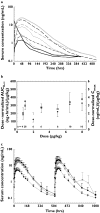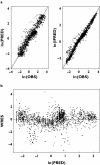Population pharmacokinetics of darbepoetin alfa in healthy subjects
- PMID: 16939525
- PMCID: PMC2000706
- DOI: 10.1111/j.1365-2125.2006.02752.x
Population pharmacokinetics of darbepoetin alfa in healthy subjects
Abstract
Aim: To develop and evaluate a population pharmacokinetic (PK) model of the long-acting erythropoiesis-stimulating protein, darbepoetin alfa in healthy subjects.
Methods: PK profiles were obtained from 140 healthy subjects receiving single intravenous and/or single or multiple subcutaneous doses of darbepoetin alfa (0.75-8.0 microg kg(-1), or either 80 or 500 microg). Data were analysed by a nonlinear mixed-effects modelling approach using NONMEM software. Influential covariates were identified by covariate analysis emphasizing parameter estimates and their confidence intervals, rather than stepwise hypothesis testing. The model was evaluated by comparing simulated profiles (obtained using the covariate model) to the observed profiles in a test dataset.
Results: The population PK model, including first-order absorption, two-compartment disposition and first-order elimination, provided a good description of data. Modelling indicated that for a 70-kg human, the observed nearly twofold disproportionate dose-exposure relationship at the 8.0 microg kg(-1)-dose relative to the 0.75 microg kg(-1)-dose may reflect changing relative bioavailability, which increased from approximately 48% at 0.75 microg kg(-1) to 78% at 8.0 microg kg(-1). The covariate analysis showed that increasing body weight may be related to increasing clearance and central compartment volume, and that the absorption rate constant decreased with increasing age. The full covariate model performed adequately in a fixed-effects prediction test against an external dataset.
Conclusion: The developed population PK model describes the inter- and intraindividual variability in darbepoetin alfa PK. The model is a suitable tool for predicting the PK response of darbepoetin alfa using clinically untested dosing regimens.
Figures

 ), 8 µg/kg (n = 10) (
), 8 µg/kg (n = 10) ( ), 6.5 µg/kg (n = 10) (
), 6.5 µg/kg (n = 10) ( ), 5 µg/kg (n = 6) (
), 5 µg/kg (n = 6) ( ), 3 µg/kg (n = 6) (
), 3 µg/kg (n = 6) ( ), 2 µg/kg (n = 6) (
), 2 µg/kg (n = 6) ( ), 1 µg/kg (n = 28) (
), 1 µg/kg (n = 28) ( ), (b) change in exposure measured by dose-normalized AUC0–∞ (□) and Cmax (✦), along with the standard deviations and number of subjects are plotted against administered darbepoetin alfa s.c. dose; (c) mean (+ SD) of model evaluation dataset serum concentration–time profiles after first and second doses for selected dose groups. 500 µg (n = 4–10) (•), 6.5 µg/kg (n = 5–10) (
), (b) change in exposure measured by dose-normalized AUC0–∞ (□) and Cmax (✦), along with the standard deviations and number of subjects are plotted against administered darbepoetin alfa s.c. dose; (c) mean (+ SD) of model evaluation dataset serum concentration–time profiles after first and second doses for selected dose groups. 500 µg (n = 4–10) (•), 6.5 µg/kg (n = 5–10) ( ), 3 µg/kg (n = 5–10) (▾). n, Number of individual observations at each time point
), 3 µg/kg (n = 5–10) (▾). n, Number of individual observations at each time point




 ), Mean (SD) observed (——)
), Mean (SD) observed (——)
 ), 90 kg (
), 90 kg ( ), 30 yr (
), 30 yr ( ), 80 yr (
), 80 yr ( )
)Similar articles
-
Exposure-response modeling of darbepoetin alfa in anemic patients with chronic kidney disease not receiving dialysis.J Clin Pharmacol. 2010 Sep;50(9 Suppl):75S-90S. doi: 10.1177/0091270010377201. J Clin Pharmacol. 2010. PMID: 20881221
-
Population pharmacokinetics of darbepoetin alfa in haemodialysis and peritoneal dialysis patients after intravenous administration.Br J Clin Pharmacol. 2007 Mar;63(3):300-9. doi: 10.1111/j.1365-2125.2006.02756.x. Epub 2006 Aug 31. Br J Clin Pharmacol. 2007. PMID: 16945116 Free PMC article.
-
Population pharmacokinetics meta-analysis of recombinant human erythropoietin in healthy subjects.Clin Pharmacokinet. 2007;46(2):159-73. doi: 10.2165/00003088-200746020-00004. Clin Pharmacokinet. 2007. PMID: 17253886
-
Pharmacology of darbepoetin alfa.Nephrol Dial Transplant. 2007 Jun;22 Suppl 4:iv2-iv9. doi: 10.1093/ndt/gfm160. Nephrol Dial Transplant. 2007. PMID: 17526547 Review.
-
Covariate pharmacokinetic model building in oncology and its potential clinical relevance.AAPS J. 2012 Mar;14(1):119-32. doi: 10.1208/s12248-012-9320-2. Epub 2012 Jan 25. AAPS J. 2012. PMID: 22274748 Free PMC article. Review.
Cited by
-
Use of Modeling and Simulation in the Design and Conduct of Pediatric Clinical Trials and the Optimization of Individualized Dosing Regimens.CPT Pharmacometrics Syst Pharmacol. 2015 Nov;4(11):630-40. doi: 10.1002/psp4.12038. Epub 2015 Nov 13. CPT Pharmacometrics Syst Pharmacol. 2015. PMID: 26783499 Free PMC article.
-
A biomathematical model of human erythropoiesis under erythropoietin and chemotherapy administration.PLoS One. 2013 Jun 6;8(6):e65630. doi: 10.1371/journal.pone.0065630. Print 2013. PLoS One. 2013. PMID: 23755260 Free PMC article.
-
Population Pharmacokinetics of Darbepoetin Alfa in Conjunction with Hypothermia for the Treatment of Neonatal Hypoxic-Ischemic Encephalopathy.Clin Pharmacokinet. 2015 Dec;54(12):1237-44. doi: 10.1007/s40262-015-0286-y. Clin Pharmacokinet. 2015. PMID: 25989868 Free PMC article. Clinical Trial.
-
Population pharmacokinetics of darbepoetin alpha in peritoneal dialysis and non-dialysis patients with chronic kidney disease after single subcutaneous administration.Eur J Clin Pharmacol. 2009 Feb;65(2):169-78. doi: 10.1007/s00228-008-0561-z. Epub 2008 Sep 21. Eur J Clin Pharmacol. 2009. PMID: 18807251 Clinical Trial.
-
Population Pharmacokinetics of Epcoritamab Following Subcutaneous Administration in Relapsed or Refractory B Cell Non-Hodgkin Lymphoma.Clin Pharmacokinet. 2025 Jan;64(1):127-141. doi: 10.1007/s40262-024-01464-2. Epub 2024 Dec 21. Clin Pharmacokinet. 2025. PMID: 39708278 Clinical Trial.
References
-
- Macdougall IC. Novel erythropoiesis stimulating protein. Semin Nephrol. 2000;20:375–81. - PubMed
-
- Egrie JC, Dwyer E, Browne JK, Hitz A, Lyjos MA. Darbepoetin alfa has a longer circulating half-life and greater in vivo potency than recombinant human erythropoietin. Exp Hematol. 2003;31:290–9. - PubMed
-
- Locatelli F, Olivares J, Walker R, Wilkie M, Jenkins B, Dewey C, Gray SJ. Novel erythropoiesis stimulating protein for treatment of anemia in chronic renal insufficiency. Kidney Int. 2001;60:741–7. - PubMed
-
- Nissenson AR, Swan SK, Lindberg JS, Soroka SD, Beatey R, Wang C, Picarello N, McDermott-Vitak A, Maroni BJ. Randomized, controlled trial of darbepoetin alfa for the treatment of anemia in hemodialysis patients. Am J Kidney Dis. 2002;40:110–8. - PubMed
-
- Vanrenterghem Y, Barany P, Mann JF, Kerr PG, Wilson J, Baker NF, Gray SJ. Randomized trial of darbepoetin alfa for treatment of renal anemia at a reduced dose frequency compared with rHuEPO in dialysis patients. Kidney Int. 2002;62:2167–75. - PubMed
MeSH terms
Substances
LinkOut - more resources
Full Text Sources

